With the craze of designer dogs, there is a relatively new one that has come in the last 30 years, a Blue heeler mix with a german shepherd.
As the name suggests, Blue heeler german shepherd mix is a crossbreed of working dogs Blue heeler (or Queensland heeler or Australian cattle dog (ACD)) and the very popular German shepherd dog (GSD).
As both of his parents are shepherd dogs, the blue heeler german shepherd mix is a very active and energetic dog who would need a lot of playtimes and mental stimulation.
Appearance of blue heeler mix german shepherd
Like any other designer crossbreed, a blue heeler mix with german shepherd will shape up based on the dominant genes. They can look like a German Shepherd or a blue heeler or somewhere in between. Still, the below traits should likely be present.
Body: They have a strong and muscular long body with broad shoulders.
Face: They have a lean face with a medium to long, deep muzzle.
Ears: They have erect pricked ears.
Coat: They have a thick double-coat between short to medium coat length. They can come in varying colors but a mix of blue and tan is the most popular.
Size: Depending on the dominant genes, the ACD GSD mix can grow to a height of 18 to 26 inches and weigh approximately 35-90 pounds.
This is a wide range and where any dog would fit would be based on whose genes are more dominant. If it is GSD, he would be heavier but if it is ACD, he would tend to be leaner.
Lifespan: They typically have a lifespan of 9 to 14 years.
The temperament of blue heeler german shepherd mix
Blue heeler german shepherd mix are working dogs that carry the traits of driving cattle. They love being engaged with work or play. And if they get bored, they may find something by themselves which could be destructive.
Blue heeler german shepherd mix will thrive on human companionship. So if you are planning to leave your dog alone for a long time, this would not be the right dog for you.
Here are a few of their personality traits that you should be aware of.
Needs a dominant leader
ACD and GSD mix may take the position of the leader of the pack if the owner is not a consistent leader. They must be trained to know their place in the pack and they should follow the owner’s commands.
Energetic and agile
Blue heeler german shepherd mix has a powerful body and are extremely energetic and agile. They would need a lot of playtimes and running or else would get bored.
This is because both the parents of this breed are working dogs who were used to drive cattle. They would enjoy being active in some work which may mean both physical and mental stimulation.
If they are not engaged actively, they may devise something of their own like chewing or scratching things that you may find destructive.
Loyal and obedient
They are loyal to their owners and family. They inherit this trait from both of their parents (ACD and GSD) who are both extremely loyal dog breeds. Given proper training, they can be highly loyal and obedient companion dogs.
Excellent guard dogs
These dogs are fearless, territorial, aggressive, and wary of strangers. This makes them excellent Guard dogs.
Intelligent but stubborn
These dogs are intelligent and learn training commands easily. But at the same time, they can be obstinate as well with their free-thinking.
Strong willed
Blue heeler german shepherd mixes are strong-willed and confident dogs. They need an experienced dog owner who can be in charge else they would be ready to take up the position of being the leader in the pack and be aggressive to others.
High prey drive
Both the parents of Blue heeler german shepherd mix have a high prey drive. This can lead them to go after smaller animals like squirrels, rabbits or cats, etc. It is a must for them to be socialized since puppy age to other pets, children, and strangers.
Avoid if you have young children
Blue heeler german shepherd mix, if properly trained, are good family dogs who do well with older children. Though for families having children aged 7 years or less, we would not recommend them.
They have a high prey drive and are considered aggressive. Young children may not know how to treat them with respect.
Noisy – depends?
Although the blue heelers are not known for being vocal, german shepherds do have a bad reputation for barking for their needs or if they are left alone for long. Being noisy for an ACD GSD mix would depend on which parent genes are more dominating.
Experienced dog owners only
With their wary to stranger attitude, prey drive, intelligent mind, and independent thinking, they are not recommended for a first-time dog owner.
Not apartment friendly
Blue heeler german shepherd mix is a very active, energetic, and agile dog. He would need a fenced yard to play and run for venting out his energy and hence not recommended for living in apartments.
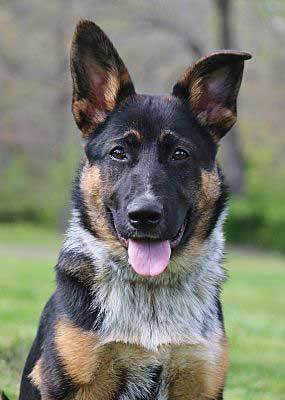
Care
Nutrition
It is recommended to give 1.5 to 3 cups of high-quality dry food divided into two meals in a day. You would need to adjust the diet based on the size, age, and activity level of the dog.
If your dog is lazy, he doesn’t need much food, while, if he is quite active, he needs a lot more.
Blue heeler german shepherd mix would need at least 18 % of the protein in his diet for growing and maintaining the health of the muscles. Meat is recommended for them as a source of protein.
We would recommend Blue Buffalo Life Protection Formula Natural Adult Dry Dog Food.
If you do make up your mind for this food, we would recommend to slowly start mixing in your dog food before completely replacing it to be sure that your pooch is not allergic to the ingredients of this dry dog food.
Grooming
ACD GSD mixes have a double coat and they do shed moderately around the year. But they will shed heavily when their inner coat blows out.
They can have a dense inner coat and a short or medium-sized outer coat based on which parent breed gene is more prominent.
It is good to groom him daily but at least twice in a week is recommended. Regular grooming would help to massage the skin to produce oil and keeping the coat healthy. It will also promote bonding between the owner and the dog.
This will also aid in keeping the hairs contained as the loosened or dead hairs will be removed by the brush reducing the chances of hairs spreading everywhere.
We would recommend Hertzko Self Cleaning Slicker Brush. It has got great reviews from dog owners and is very easy to groom. Its self-cleaning feature is great and makes removing hairs from the brush hassle-free.
Blue heeler german shepherd mix needs bathing once in four to six weeks or when you feel he is dirty or smelly. Frequent bathing may lead to dry skin and other skin related ailments. Choose a natural oatmeal based shampoo.
We recommend Earthbath Oatmeal & Aloe Shampoo.
You should also need to clip his nails once every month. This would help to minimize the risk of nail splitting which could be very painful to the dog.
Exercise
Blue heeler german shepherd mix is an extremely agile dog who needs a lot of exercises and playtime. They need lots of mental and physical stimulation. If you are an active jogger, he would be an ideal companion.
Just the daily walks may not suffice the needs of this active and energetic dog. He can play all day and hence it is recommended for folks who have a fenced yard where he can vent out his energy.
Training
They are smart dogs and are easy to train. They will learn the commands quickly. At the same time, they can be obstinate due to their independent thinking. So you should start the training since the beginning.
Here are a few tips to train a Blue heeler german shepherd mix.
- Start the training at puppy age.
- Start with simple commands like sit, stay, and stand.
- Positive reinforcement training works better with them.
- We recommend obedience and crate training as a must for them.
Obedience training helps to make them follow your commands and subvert their aggressiveness and high prey drive. Crate training helps them to feel safe when alone.
They should also be socialized early with other dogs, pets, and humans so that they can become a well-adjusted dog.
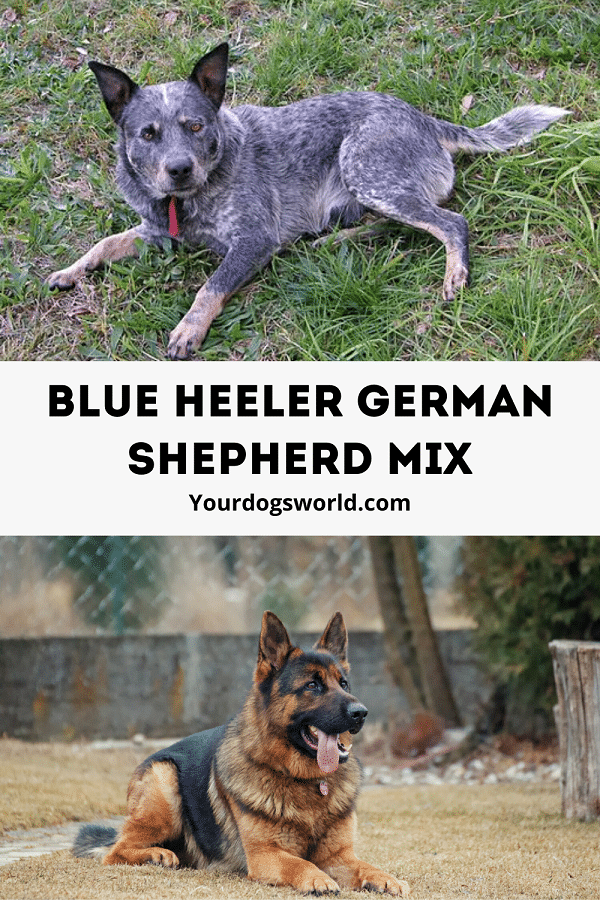
Health
They are generally healthy crossbreed dogs but they can be prone to certain health issues. It is not necessary to have the disease but as a responsible dog owner, you should be aware of what disease your dog may be prone to. Some of them are listed below –
Hip dysplasia
This is a genetic disease in which thigh bone doesn’t fit properly in the hip joints. This can be painful in various intensities in different dogs but finally leads to Arthritis. This can be inherited and dogs having this medical condition should be neutered.
Elbow dysplasia
Elbow dysplasia is an inheritable medical condition involving multiple developmental abnormalities of the elbow-joint in the dog.
Progressive retinal atrophy (PRA)
This is a disease that leads to gradual blindness. The dog would start to lose his night vision first and then slowly it leads to complete blindness in a couple of years. This again can be inherited and the dogs having this should not be bred.
Deafness
This is a genetic disease prone to Queensland Heelers and can be passed upon. This could affect single or both the ears. This can be tested at the puppy age by doing the Brainstem auditory evoked response (BAER) testing.
How to get a Blue heeler german shepherd mix puppy?
So you do not want a lazy pooch and have made up your mind for a Blue heeler german shepherd mix, let us look at how you can find a puppy for you.
It would not be an easy task to find this designer dog breed. You should check first for the local shelters of blue heeler and then GSD ones and check if you can see this crossbreed. There might be a dog waiting for a new life.
Though you may not know the details about him so it is best to spend some time before finalizing and taking him home.
If you can’t find one at a local shelter, it would be difficult, though not impossible, to find this crossbreed at a breeder of repute.
Pros and Cons
| Pros | Cons |
|---|---|
| Intelligent | Can be stubborn and difficult to train |
| Loyal | Not recommended for family with small children |
| Highly Energetic | Needs time for grooming |
| Excellent watch dog | Can be destructive if not engaged in work or play |
| Prone to separation anxiety |
Origins – Details about parent breeds
This is relatively a new crossbreed and has been known for the past 30 years. Let us look at their parent breeds as well to understand their lineage.
Blue Heeler
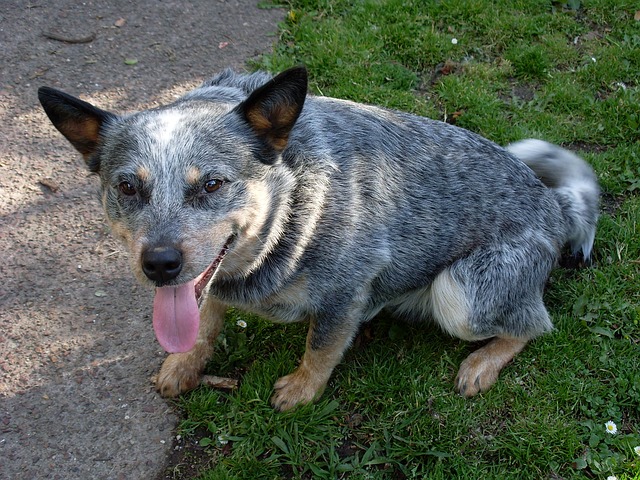
Blue heelers have been credited to the growth of the Australian Beef industry. When the Early Britishers settled in Australia, they had the challenge of moving large groups of cattle across hundreds of miles to the Sydney markets. Frequently, they used to lose cattle in the midway.
This led to the chase of creating an ideal cattle herding dog. So the old English sheepdog was cross-bred in the early 1800s with multiple dogs like Australian Dingoes, collies, and Dalmatians. This is how Blue Heeler aka Australian Cattle dog was developed.
The blue heeler is an Australian Cattle Dog with color coat of blue. They are strong, compact, and muscular dogs with a deep muzzle and erect ears.
They are a bit longer than tall that used to help them to nip the feet of the cattle while driving them without getting hurt.
Australian cattle dogs are highly energetic, strong, and intelligent dog breed who can be obstinate at times due to their independent thinking. They have a high prey drive and are inherently wary of strangers.
Blue heeler can grow to a height of 18 to 20 inches and weigh approximately 30 to 50 pounds. Their average life span is around 12 to 15 years.
German Shepherd
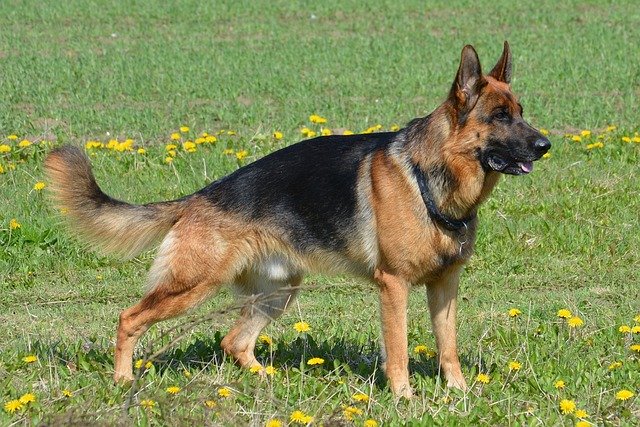
German Shepherd is the second most popular dog in USA as per American Kennel Club.
They are medium to large size dogs originally bred in Germany by Captain Max von Stephanitz as a herding dog for flocking the animals.
But as Germany industrialized, these dogs became popular as a working dog across the world for their strength, intelligence, trainability, and obedience.
German Shepherds have a strong muscular body and are longer than tall. They have a square head with a long muzzle and pricked erect ears.
German Shepherds are energetic and easily trainable for the task. They are territorial and wary of strangers. Being curious, courageous, and loyal as well, they excel as watchdogs and are popular as a police or military dog. They require early training and socialization.
German Shepherds are not for folks who are allergic to dogs. They shed a lot and are sometimes also called “German Shedders”.
They can grow to a size of 24 to 26 inches and weigh approximately 75 to 95 pounds. The average life span of the German Shepherd is 10 to 14 years.
Final thoughts
Given their high prey drive, tendency to be aggressive, and having independent thinking, we would only recommend this dog to an experienced dog owner who would be willing to invest the time and effort to care for and train the dog.
If you can do that, Blue Heeler german shepherd mix would be the right dog for you!
Just to summarize, you should have an active lifestyle and a fenced yard for this dog to play and enjoy venting out his energy.
If you own or know one, do let us know your experience in the comments!

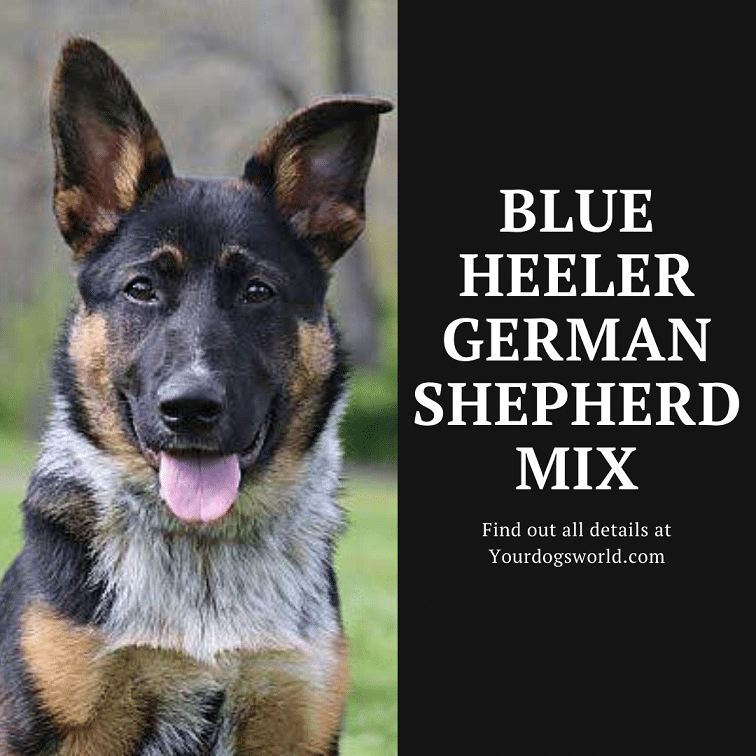
we have this puppy and named her Sadie. She is 4 months old and about 60 pounds. She is full of energy and stubborn. She is also extremely smart. She is the alpha dog and our vet has encouraged socializing. We wanted to professionally train her but the pandemic changed that. We use a training collar from a prior trainer (I had a german shepherd) but she is still stubborn and wants to do things her way. She is extremely affectionate. Our older dog can not and does not want to mimic her enegy and therefore they are separated for some of the day.
Blue heelers are a lot in themselves. Hope she is doing great! Keep doing small training sessions. I am sure you know consistency would be the key.
Hope this lockdown ends soon and you get the professional help for Sadie.
I have a 9 month old blue heeler/german shepherd mix and he is very energetic. He could play for hours on end. I got him two months ago from a single guy and I’m a mom with three girls, two under the age of 5. He’s been really great with them. He did have to adjust to learning how rough to play with them, but now he gets it and knows how to playfully bite.
We take him to the dog park a few times a week so he can swim and play with other dogs. He does suffer a lot from separation anxiety so in the beginning, he would go everywhere with me. He’s getting better at that also now. Very trainable and I’m happy to have him as part of our family now! I hadn’t had a dog since high school, so I’ve been learning a lot.
They are quite enthusiastic, energetic, and would continue to play without exhaustion. Glad that you brought them on board.
We have 2 10 month old puppies that are litter mates. We adopted them from a rescue group and knew that the mother is a black lab. We are experienced dog owners, but we wanted to get a family friendly dog since we have small children. We have since found out that the puppies are 50% Labrador, 25% Australian cattle dog, and 25% GSD. I’ve just been doing some research on blue heeled/gsd mixes to better understand their temperaments. They love the children, but we have had to work with them quite a lot with our cats. They don’t harm them, but they constantly want to chase them. We’ve also had issues with them herding the children. So, there’s way more training needed than we originally expected from adopting some lab mixes